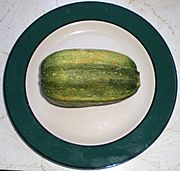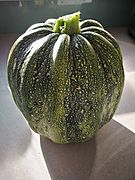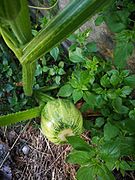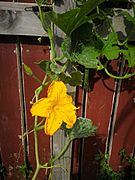Kamokamo facts for kids
Kamokamo, also known as kumikumi, is a special type of squash grown in New Zealand. It's a bit like a pumpkin or zucchini. Scientists call it Cucurbita pepo. People think it first came to New Zealand when Europeans settled there, around the late 1800s or early 1900s. The name "Kamokamo" comes from the Māori language, which is spoken by the native people of New Zealand.
Contents
Kamokamo: A Unique New Zealand Squash
Kamokamo is a type of squash that looks a bit like some squashes found in Mexico. Its fruit has deep ridges and a sturdy shape. The skin is often green with speckles of white. Over time, different kinds of Kamokamo have grown in Aotearoa New Zealand, showing how it has adapted.
Where Does Kamokamo Come From?
Kamokamo has been a very important food for the Māori people of Aotearoa New Zealand for a long time. In the 1800s, people traded Kamokamo all around New Zealand. This helped it spread to many different areas.
How is Kamokamo Used?
Kamokamo is a versatile plant, meaning it can be used in many ways. It's not just for eating!
Eating Kamokamo
Kamokamo fruits taste best when they are young and not fully grown. At this stage, they are tender and delicious. They can be cooked in many ways, similar to how you might cook other squashes.
Traditional Uses
When Kamokamo fruits get older and fully grown, they become very hard. People traditionally used these mature fruits as containers. They would hollow them out and use them to store things, like the pulp from ripe tutu berries. This shows how clever people were at using all parts of the plant.
Growing Kamokamo
When growing Kamokamo, farmers need to be careful. They must protect the plants from something called "cross-pollination." This happens when pollen from one type of plant mixes with another. If this happens, the Kamokamo might not grow into the desired shapes. Careful planting helps make sure the fruits keep their special look.





